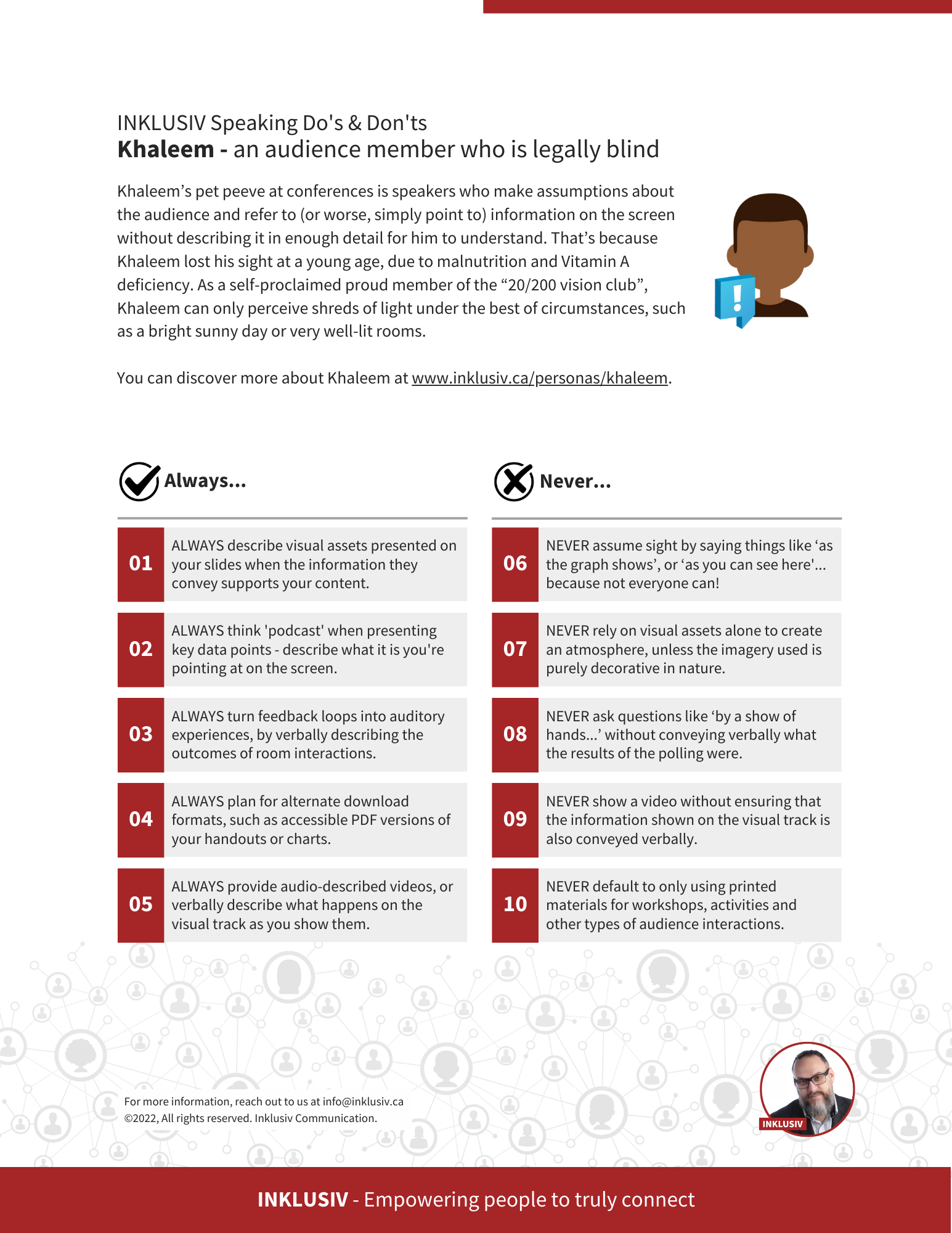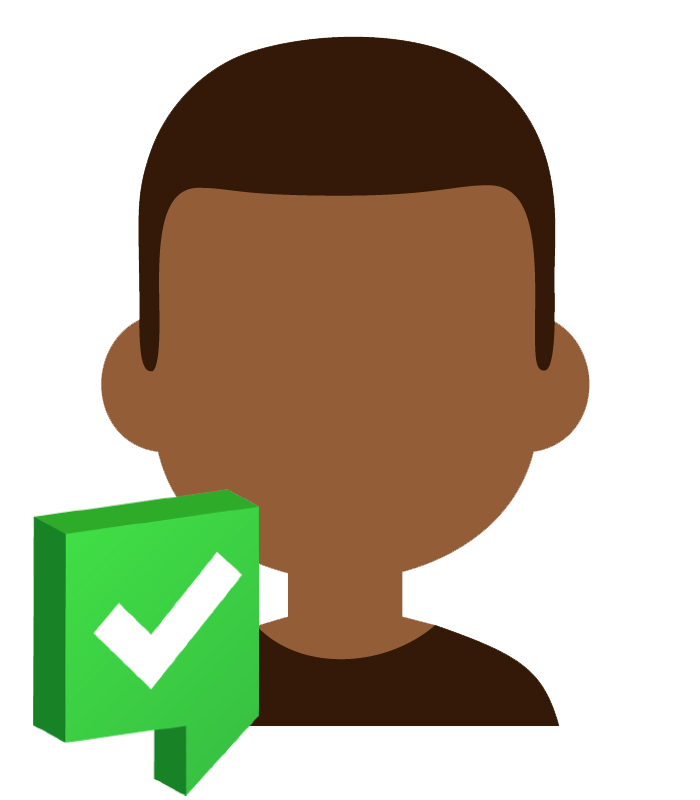Introducing Khaleem (he/him), an audience member who is legally blind
Khaleem was always a very creative person, who had an easy time escaping to an imaginary world as a kid. Born to a very poor family, escaping to a world where everything was perfect shielded him from traumas. “When you’re the only blind kid in the neighbourhood, friends are incredibly hard to come by, so you make up some of your own”, he finds himself explaining very now and then. “My mother would read to me for hours, I could never get enough. It’s all I really needed”.
It’s no surprise, then, that Khaleem turned this very creative mind of his towards writing when he found out about computers at the public library. That led him to discover audio books, the Internet, assistive technologies such as screen and braille readers, and a whole new world materialized for him. All of a sudden, he could dive even deeper into his imagination, discover amazing worlds and characters, and escape the reality of his own, underprivileged household.
Later, as an up and coming science fiction writer, Khaleem became passionate about storytelling, and found himself drawn towards speakers who were masters at telling stories. As a result, he attends a lot of conferences annually, and enjoys TED talks in general, for the caliber of storytelling one typically finds over there. But even with master storytellers, Khaleem is often painfully reminded that he doesn’t quite belong, as speakers who are not familiar with basic inclusive communication principles will often tend to create highly visual experiences which remain inaccessible to him. Slides and memes are shown, but not verbally conveyed. Outcomes from room interactions are not summarized for him to understand. Printed handouts are useless, and digital versions are usually inaccessible to his screen reader.
These situations, and so many more, cause him to often feel left out. “If speakers only realized the power they have over my ability to succeed, they’d surely pay more attention to people like me”, he often thinks to himself.

“Verbally describing visuals and key data points would go such a long way towards helping me understand what the speakers refer to, or talk about in their presentations!”
Khaleem’s Do’s and Don’ts Poster

Inclusive Speaking Do’s & Don’ts – Khaleem
As speaking professionals, we pride ourselves on mastering the ability to engage our audience and change their lives with our thoughts and ideas. But just how inclusive are you really, when it comes to touching the hearts and minds of audience members like Khaleem who are legally blind? Below are some of the basic Do’s & Don’ts that speakers should always keep in mind, when communicating their message to audience members who cannot rely on their sight to perceive information.
As a speaking professional trying to engage someone like Khaleem, always…
01. Describe visual assets presented on your slides when the information they convey supports your content

Do you systematically describe visual assets presented on your slides when the information they convey supports your content? There’s no denying that visual assets, when used efficiently, can be incredibly impactful, creating long-lasting impressions on our audience members. They embellish our assets and convey critical information, oftentimes in ways that are infinitely more powerful than words. The old saying, “a picture is worth a thousand words” certainly has value, but it only applies as long as people can see said image! If you rely on imagery, graphics, and other visuals to convey important information in your slides and handouts, make it a point to always describe those assets visually, so everyone can fully benefit from the information they convey. Otherwise, if you simply refer or point to them, how is someone like Khaleem supposed to perceive them and benefit from them?
02. Think 'podcast' when presenting key data points by describing what it is you're pointing at on the screen

Do you systematically think ‘podcast’ when presenting key data points by describing what it is you’re pointing at on the screen? Figuring out how to describe a visual in a presentation is easier said than done. How should I do this, so it doesn’t feel forced? How many details should I provide? How much information is too much? One of the best pieces of advice I was ever given by a blind friend of mine when it comes to defining how to best describe a visual asset is to imagine presenting it to someone over the phone, or while appearing on a podcast. What words would you use to describe this important visual if you knew your audience would only be listening in? Those are the exact words that Khaleem needs to be on equal footing as anyone else in your audience who doesn’t have a vision impairment.
03. Turn feedback loops into auditory experiences by verbally describing the outcomes of room interactions

Do you systematically turn feedback loops into auditory experiences, by verbally describing the outcomes of room interactions? The natural tendency of audience members, when the group is asked to weigh in on a question by show of hands, is to look around the room to estimate what the outcome was. Consequently, speakers oftentimes don’t bother describing how many hands were raised, assuming everyone could determine this for themselves in the process. You can already see what the issue is. Whenever you ask your audience to raise their hand if they agree with you, ask them by show of hands if they relate to a particular situation, or invite them to take position on something, you need to verbally describe the outcome of those interactions to the entire room, so people like Khaleem can also appreciate how it panned out. Otherwise, some folks will be left out.
04. Plan for alternate download formats, such as accessible PDF versions of your handouts or charts

Do you systematically plan for alternate download formats, such as accessible PDF versions of your handouts or charts? Providing handouts and other supporting documents in your presentations is not only a great best practise to foster engagement from the audience, but also a fantastic way to leave something behind, so participants don’t forget about you once the session is over. But printed documents will only get you and your participants so far: they can easily be discarded, stained, wrinkled, damaged, or lost. Planning for downloadable assets offers many advantages over printed ones. Not only do you not have to carry them around with you, and they’re better for the environment, but they can also be made available at will, so that folks like Khaleem can also take advantage of them using their assistive technologies — if you make them fully accessible, of course!
05. Provide audio-described videos or verbally describe what happens on the visual track as you show them

Do you systematically provide audio-described videos or verbally describe what happens on the visual track as you show them? It’s one thing to provide captions for videos used in presentations, but captions won’t do Khaleem much good since he can’t read them! For people like Khaleem, the experience of watching videos is entirely auditory. As a result, any relevant information only conveyed visually will inevitably be missed. To make videos that are accessible to folks who have visual disabilities, on top of captions for those who are deaf or hard of hearing, an additional audio track that captures the relevant information must be provided as audio-described feedback. To determine whether your videos require audio description, watch them with your eyes closed. Any valuable content missed is what needs to be captured through that voice-over track. Alternatively, you can always describe them orally, as the videos are running.
As a speaking professional trying to engage someone like Khaleem, never…
06. Assume sight by saying things like “as the graph shows,” or “as you can see here...,” because not everyone can

Do you systematically avoid assuming sight by saying things like “as the graph shows,” or “as you can see here…,” because not everyone can? Have you ever been annoyed by a speaker making assumptions about what it is that you knew, or should have known, but didn’t? Using words like “obviously” or “of course” when what they were referring to was something that was anything but? If so, you understand how folks like Khaleem might feel when we use phrases like “as you can see here,” or “as this graph shows,” without following through and verbalizing what it is that they, as audience members, are supposed to be seeing. You should never assume that everyone can clearly see what you are referring to or pointing to on your slides. If it’s important enough to be presented, then it’s also important enough to be described! Never make assumptions about what others can actually perceive.
07. Rely on visual assets alone to create an atmosphere unless the imagery used is purely decorative in nature

Do you systematically avoid relying on visual assets alone to create an atmosphere unless the imagery used is purely decorative in nature? Imagery can be very powerful. There’s no doubt that the right visual, used efficiently, can have dramatic effects, as well as touch the hearts and souls of audience members who see them. But visuals used in isolation can be a great source of frustration for folks who cannot see them. Just like in Khaleem’s introductory story, the feeling of hurt and rejection can be disheartening when audience members can tell that something meaningful is happening on the stage or screen but have no way to tell what’s going on. If you’re going to rely on visual props to trigger different emotions from the audience, then make sure the same emotions are also achieved by supporting those props orally, so everyone can experience them in a modality that works for them.
08. Ask questions like “by a show of hands...” without conveying verbally what the results of the polling were

Do you systematically avoid asking questions like “by a show of hands…” without conveying verbally what the results of the polling were? By show of hands, how many of you have ever asked your audiences to weigh in on something…by show of hands? You know the drill. You ask a question. Audience members raise their hand if they relate or recognize themselves in what was asked. It’s a nice way to get people to engage, to weigh in, to take part. Nothing wrong with that. The problem doesn’t lie with asking the question…the problem is how it’s asked, and whether the outcome of that feedback loop is shared with those who may not be able to gauge for themselves how many people in the audience interacted. To be inclusive of people like Khaleem, always describe the outcome of the interaction with the audience so no one is left behind.
09. Show a video without ensuring that the information presented on the visual track is also conveyed verbally

Do you systematically avoid showing a video without ensuring that the information presented on the visual track is also conveyed verbally Most people would think that only deaf or hard of hearing people need accommodations for video content, but nothing could be further from the truth! Whenever your videos show content or information that happens on the screen without being explicitly announced through words, people like Khaleem will miss on that information. And it happens a lot more often than people realize. Videos showing words on the screen that are not voiced, information only presented on the visual track and entire scenes that take place without dialogue to the sound of catchy music are all examples of videos that will leave someone like Khaleem behind. Whenever you notice these gaps in the videos you use, make it a point to fill in the blanks for your audience members who can’t see.
10. Default to only using printed materials for workshops, activities, and other types of audience interactions

Do you systematically avoid defaulting to only using printed materials for workshops, activities, and other types of audience interactions You went out of your way, creating handouts that are guaranteed to make your workshop that much more engaging for everyone. That’s great! But have you given any thought as to how usable those printed copies will be to someone who has low vision and requires larger prints, or worse, someone who happens to be legally blind, like Khaleem? How useful will these handouts be if the audience member can’t read them because the fonts are too small, or because they can’t see? How do you think these folks will feel, knowing their needs were overlooked, again? Printouts are fine, if that’s what you want to do, but never settle just for printouts. Also plan for accessible, electronic copies that will be much more accommodating for those who have disabilities.
Did you know?
21% of all lawsuit cases in 2019 were about companies being sued at least for the 2nd time, demonstrating that unless you act fast, there is a very high likelihood that your organization will receive another complaint before you can even recover from the previous one. Data shows that companies with multiple brands, websites and apps are most targeted. Are you doing everything you can to mitigate risks?